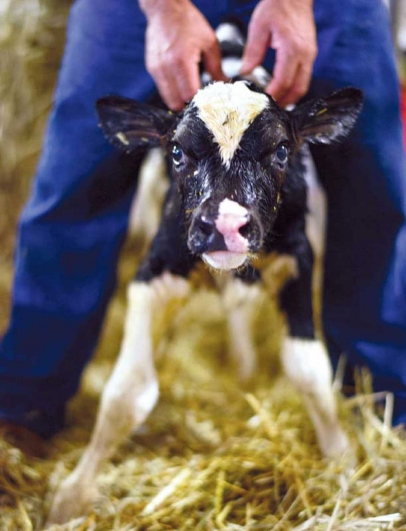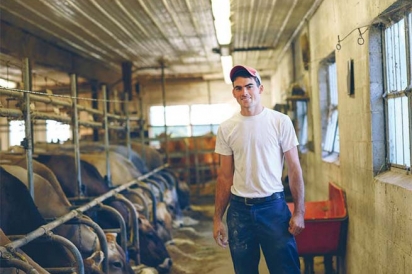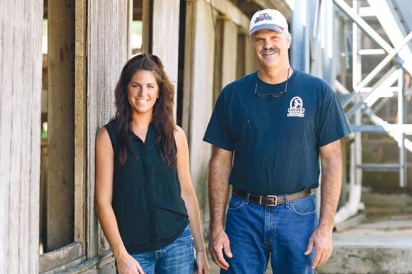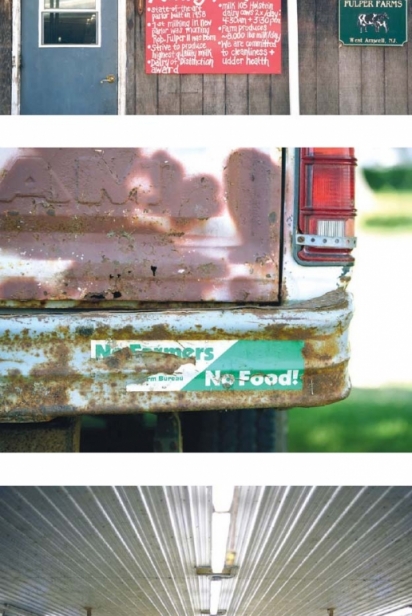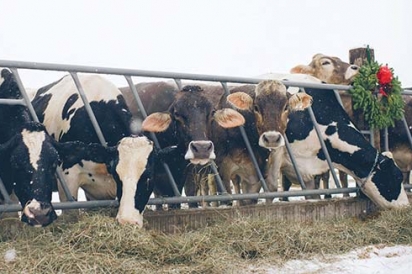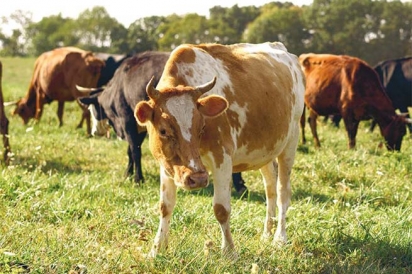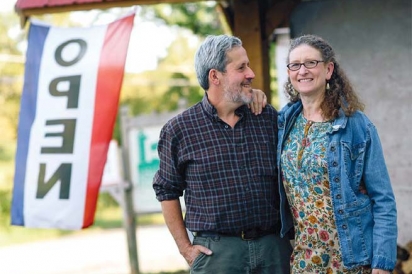The Bottleneck: NJ Dairy Farmers
New Jersey dairy farmers have milk to sell and local customers who want to buy it — but no way to make the direct sale
Breanna Fulper Lundy is concerned about the number of children who don’t know where milk comes from.
“To me it’s scary that kids don’t understand that milk comes from an animal,” says the fifth-generation New Jersey dairy farmer. “That it’s a natural product and it comes from the udder of a cow.” New Jersey shoppers might be surprised to find that they are as clueless as those children about the origin of most of the milk that sits on our supermarket shelves. That is because, short of being incarcerated (the New Jersey Department of Corrections operates their own dairy farms and processing facility) or owning a cow, the average consumer has no way to get milk that can be traced back to a New Jersey farm—making it impossible for New Jersey residents to purchase milk that directly benefits our state’s dairy farmers.
While much of the milk produced by our state’s remaining dairy farms is processed in-state, those processors say it is not logistically or economically possible to run batches of New Jersey–only milk. Instead, they combine Jersey-produced milk with milk from nearby states before packaging it for retail sale. Raw milk, which is often sold directly from the farm in neighboring states, is illegal in New Jersey. And none of our dairy farmers have yet taken on the substantial cost of building an on-farm milk processing plant.
And so milk remains one of the last major foods that has not been successfully localized by New Jersey’s farm-to-table movement. But with farmstead cheesemaking now gaining popularity, can locally produced and bottled milk be far behind?
A DISAPPEARING WAY OF LIFE
Once numbering in the thousands, New Jersey has lost most of its dairy farms—following the national migration of milk production to larger farms in western states. New Jersey’s remaining dairy farmers are a tight-knit group, bound by a common experience that few outside their industry understand.
“Growing up on the farm as a kid, you work harder than any other person in your grade,” Lundy says of her childhood on Fulper Farms in West Amwell. “I can remember getting up at 4:30 in the morning to milk and working till nine o’clock at night stacking hay—missing friends’ birthday parties or not getting to do everything that every other kid gets to do.” Because her childhood friends had no connection to agriculture, Lundy says she made it her job to introduce them to farming. When friends visited, they played in the milking parlor and learned how to show cows.
Melanie Richman of Myerwood Farms in Pilesgrove agrees. “Dairy farming is unique in the dedication it takes, 24/7/365,” she says. “It is truly a lifestyle and not an occupation. Even if it is 10° with seven inches of snow on the ground, all dairy farmers must work outside and care for their animals.” With 350 milking cows and almost 1,000 acres of owned and rented farmland, Myerwood is one of the largest dairy farms in the state.
Dairy farmers don’t always agree about how best to care for their cows. For many, cow comfort means keeping their cows sheltered with bedding, continuous access to feed, and fans and misters to keep them cool. For others, it means turning their cows out to pasture and returning to grazing as their sole or primary source of feed. Regardless of their philosophy, one common sentiment expressed by New Jersey dairy farmers is the love they feel for working with cows, which may explain why they remain in dairy farming given that they have so little control over the price they are paid for their milk.
CHALLENGES OF DAIRY FARMING
Like all farmers in New Jersey, dairy farmers must navigate the challenges of farming in the nation’s most densely populated state. The price of land makes expansion a pricey strategy. Close proximity to houses and towns results in tense community relations over odor, noise and the use of agricultural chemicals.
The loss of dairy farms has meant the loss of the infrastructure to support those farms. “Right now we don’t have dealer support for our milking equipment, our farm equipment, our feeding equipment— everything is two hours away,” says Robert Fulper, Lundy’s father and co-owner of Fulper Farms. “We have to fix it ourselves, which means I have to stock extra parts because I can’t afford to have milking equipment go down on a Saturday night and not be able to milk till Monday morning.” When sending their milk to be bottled, New Jersey dairy farmers have very few options. Only three large dairy processors remain in the state—Cumberland Dairy in Bridgeton, Garelick Farms in Florence, and Readington Farms in Readington—along with a few small ones, such as Halo Farm, which sells milk at their processing facility in Trenton.
The razor-thin margins on milk mean that dairy farmers need to be extra vigilant at controlling their costs. Most grow much or all of their own feed, which often includes genetically modified corn—a crop that some farmers view as a sustainable choice and others as a necessity that puts them at odds with current consumer trends. “I know everyone’s against it,” says Jared Weeks, who uses a combination of grazing and supplemental feeding to manage 150 cows on 300 acres of rented land in Ringoes. “I’m not for it, but with the amount you have to put out to plant corn, and how heavily I rely on it for feed, I can’t take the risk of losing a crop. It’s a huge, huge output and you have to have some kind of security that you’re going to have a crop. With non-GMO, I would develop an ulcer worrying.”
Although there are many organic dairy farms in Pennsylvania and New York, the high price of land and difficulty in making direct sales of milk to consumers has made going organic a less attractive choice for New Jersey dairy farmers. While organic milk retails at a higher price than non-organic milk, it isn’t necessarily more profitable for the farmer—especially those who feed grain. (Organic grain went from $380 per ton in 2006 to $720 per ton in 2012.) Erich Bremer, supervisor of the Organic Certification Program at the New Jersey Department of Agriculture, reports that, apart from one farm currently exploring certification, it has been several years since his department has received an inquiry from a dairy farmer looking to transition to organic.
STRUCTURE OF THE MILK INDUSTRY
One of the greatest challenges dairy farmers face is the unpredictable swings in the price they are paid for their milk. That price is tied to the federally formulated milk marketing order, which sets the minimum price that processors must pay farmers. How that price is set—and why and when it fluctuates—is a mystery to most farmers. “I cannot begin to tell you how milk is priced because it’s so complicated,” Fulper says. “I don’t want to spend my energy on figuring it out because I can’t change it.”
Even though dairy farmers have long been forced to take whatever price is offered to them for their milk, dairy farming once provided a good living to the farmers of our state. In recent years, however, the price they receive for their milk has often not covered the cost of production, let alone provided the farmers a profit. Moreover, the unpredictability and swings make it hard for farmers to plan.
“Prices are good right now,” says Weeks, who started in farming in 2005 at the age of 18. “But anyone who’s milking cows will tell you when prices are good you’re just waiting for them to get bad. There’s no stability, that’s the biggest problem in this industry. It’s hard to plan because you don’t know how much you’re going to be making until they give it to you.” Weeks says he is still catching up from losses he incurred when milk prices crashed in 2009.
Farmers focus, instead, on the factors they can control. “We try to produce the highest-quality milk we can to receive the highest bonus for quality,” Richman says. (Price premiums for quality are based on the cleanliness of the milk and the fat and protein content.) Richman explains that additional ways to increase profitably are to lower input costs and produce the most volume of milk possible per cow. Volume is controlled through a combination of genetics, targeted feeding, and ensuring a comfortable, stress-free environment for the animals. (None of the farmers interviewed for this article use bovine growth hormone to increase production, a technique used in the dairy industry since 1994 but often selected against by concerned consumers.)
One premium that our dairy farmers have not yet been able to capture is the premium paid by consumers for other locally grown foods in our state. “Our milk is treated as a commodity,” says Fulper, voicing the frustration of many farmers. “We sit in New Jersey—right in the middle of the market, right where the people are, and we cannot capitalize on it.”
DIVERSIFYING
Some dairy farmers, such as Richman, stick solely with milk, choosing to invest in infrastructure and equipment in order to increase their quality and yields. Others diversify to help increase revenue and buffer against volatile milk pricing. Weeks, for example, grows some vegetables, which he sells at his Hun-Val farm stand, along with eggs and some cheese that is made for him by a processor in Pennsylvania.
Although milk is their main business, the Fulpers have been diversified for much of their farm’s more-than-100-year history. That currently includes producing hay for the equine industry, rye straw for the racetracks, and commodity grain. They have also created Fulper Family Farmstead, which brings the public onto the farm through summer camps, private parties and tours. This has the dual role of generating revenue and bringing the public into the world of dairy farming. “We have to educate the next generation and the people in our local community because ultimately they are the ones who can or cannot support us,” Lundy says. “If we’re going to stay in the same Central Jersey area for another century, we really need the younger generation to grow up supporting agriculture.”
Summer camp participants care for a calf over the course of a week on the farm—learning how to wash, clip, and properly handle it for the show ring. Campers also get the chance to milk a cow, watch a cow give birth, and make homemade ice cream.
In 2012, Fulper Family Farmstead introduced a new line of products made from their milk—yogurt, mozzarella and ricotta cheeses— which are sold at farmers’ markets and some retail stores. They are able to do this because they finally found the Holy Grail of local dairy—a small processor, Mondo Dairy Farm, that is willing to separate out their milk and create value-added products that the Fulpers can confidently say are from their farm. Located in Paterson and Ridgefield, Mondo is owned by Jack Taranto, a Sicilian-born cheesemaker who is committed to helping New Jersey dairy farmers. “I don’t want to see any farm go out of business,” he says—adding that the state of New Jersey should do more to help dairy farms remain viable.
NOT JUST A BUSINESS
Despite the instability and challenges, dairy seems to exert a unique hold on farmers. Harrell’s father tried to get out of dairy—selling his Holstein herd in the 1980s—but missed his cows so much that he bought a herd of Jerseys and resumed milking. “People just don’t understand,” says Lundy, who recently married a fellow dairy farmer. “It’s not just a business, it’s a way of life. Your cows are your family, you’re with them all of the time.”
Weeks, who fell under the spell of dairy farming in his youth, says he still loves getting up early each morning and coming to work, but profitability is a constant concern. He holds on to hope that solutions to the crisis in New Jersey dairy will come before it is too late. “It’s a shame that everyone has to wait until something disappears before they try to revive it,” he says, urging instead that we figure out solutions now, “while there are still some dairy farms around trying to survive.”
NEW JERSEY DAIRY STATS:
According to New Jersey Secretary of Agriculture Douglas H. Fisher, there are 64 commercial dairy farms remaining in the state, producing approximately 10 million pounds of milk per month, which is about 6% of the total state consumption of fluid milk. Over the past 18 months, two new dairy operations have opened and one is in the planning stages. Also during this time three new dairies have moved into existing operations.
New Jersey’s dairy production is centered in Salem and Gloucester Counties, which are home to the largest dairies in the state. Sussex and Warren Counties hold most of our state’s northern dairy farms, with some also located in Hunterdon, Somerset, and Monmouth Counties.
The state’s largest milking herd tops out at around 600 cows, with small herds ranging from 50 to 75 and midsize from 150 to 250. —Fran McManus
THE LATEST ON RAW MILK
A push to legalize the sale of raw (unpasteurized) milk in New Jersey has been going on in state government for several years. Advocates argue that raw milk provides unique and important health benefits and that onfarm sales will give dairy farmers an additional source of much-needed income. Those opposed to legalization, which includes food industry organizations such as the New Jersey Food Council, argue that raw milk poses a significant risk to human health. New Jersey’s dairy farmers fall onto both sides of the debate, although farmers who support legalization also advocate strongly for additional safety testing of raw milk and dairies that sell raw milk.
According to the Farm-to-Consumer Legal Defense Fund, the sale of raw milk is currently legal in 33 states through wholesale distribution, on-farm sales or cowshare programs in which consumers share in the ownership of a cow and its production. It is illegal to transport raw milk across state lines.
Bills to establish a raw milk permit program—which would allow permitted dairies to sell raw milk directly to the public and to retail stores—are currently under consideration in both the New Jersey Assembly and Senate. —Fran McManus
THE HERETIC HERDSMAN
Jonathan White follows his own rules at Milford’s Bobolink Dairy
Like most dairy farmers, Jonathan White grows his own feed. Then he diverges from the norm and leaves his 100-plus cows outside 24 hours a day, 365 days a year, to harvest the feed themselves. Leaving cows outside year-round and feeding them an all-grass diet are just two of many dairy heresies that White practices daily at Bobolink Dairy in Milford.
As White walks his cows down from the pastures to be milked, several other heresies are in evidence. Three baby calves mingle with the milking herd, suckling from their mothers as they make their way to the barn. In the milking herd is a 24-year-old cow, which calved this year. Like all cows on the farm, she was bred the old-fashioned way—in the field, bull on cow.
While most dairy farmers begin the first of two daily milkings in the predawn hours, the sun has been up for several hours as the Bobolink herd meanders toward the barn for their once-a-day milking.
As we follow the herd down the shaded path that skirts a deep ravine, White explains that this un-farmable cut—created by a half century of run-off from mismanaged fields during the previous owner’s tenure— provides winter refuge for his herd.
“The risky time of year for cows is not when it’s bitter cold or extremely hot. You can prepare them for both of those,” White says. “The real danger is when it’s just above freezing and it’s raining and the wind is blowing. Then, they can go hypothermic, just like that. When it’s anywhere from 28° to 45° and raining and the wind is blowing, we feed hay in the ravine so that they’re out of the wind.” In addition to producing milk for Bobolink’s farmstead cheeses, White’s cows have another job: They are an integral part of healing and improving the land on his 185-acre farm.
“When we first looked at the farm in 2009, it was a wreck—these fields were corn stubble, broken shale, clay, poison ivy, multiflora wild rose and wild garlic,” White says. “As we graze, the soil gets better. Now this field looks pretty good. After three seasons of grazing, we found grass with roots 24 inches deep. It’s amazing how fast cows can restore land.”
Jonathan gets less milk from his cows than production dairies do, but he also has extremely low feed and energy costs compared to input- and energy-intensive dairies. He frees himself from the milk price by turning his milk into high-value cheese that retails for $24 a pound and more. And he relies heavily on nature’s inputs to feed his cows.
“Sunlight and rain are the big inputs, plus CO2 and nitrogen from the atmosphere,” White says. “The price of those don’t go up. Actually they go down, because as you improve your soil assets through grazing, the capacity of the soil to hold nutrients increases, and its capacity to produce new nitrogen through fixation increases. What has just happened to us in this last year is that the output of our land in cheese, and therefore dollars, has shot up. We’re getting something like 50% more cheese per acre than we got two years ago. And that’s from the improvements to the soil.”


